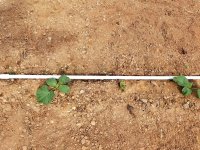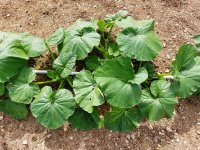CMV
Platinum Member
So all 4 patches have sprouted and seem to be growing well. 3 of them (white Flat Boer Ford, white New Moon F1, orange Kratos F1) were done in tilled areas and planted in rows. Spread 10-10-10 granular fertilizer at about same rate you would do a lawn before tilling. 4th area (orange Field Trip F1) were done in mounds as the ground was too rock infested to till. Mounds are just scoops (appx 1/2 yd) of topsoil which is mostly red clay though. All seeds were from Harris and have their "FarMore" treatment - not sure exactly what that does, but seeds were bright bluish-green and real easy to see! So some questions:
#1 When do I thin them? How long should they grow/how big before I can assume plant will live and can thin its neighbor?
#2 When thinning, ok to just transplant to an area in a row that has space? A few sections or mounds, nothing sprouted so could move a plant while thinning.
#3 Watering from IBC tote and PVC drip line. So far have been doing that about every 3rd day and no rain since they went in ground. I *think* I should cut that back to once per week if no good rain fall or else roots won't grow deep and they will depend on constant watering. Just not sure when to do that - i.e. how big should the plant be that it has enough root system to be OK with weekly watering?
#4 Using water soluble Miracle Grow as fertilizer to get them started. The StaGreen brand from Lowe's since a little cheaper than Miracle Grow but appears to be same thing. 24-8-16. Rate on package is 1 tbsp per gallon for outdoor plants, 1 tsp per gal indoor plants. Obviously mine outdoors, but since the watering is really concentrated right at base of plant I'm mixing it at appx 2 tsp per gal (2/3 tbsp). Also convenient as that's the ratio a 5lb container into a 330 gal IBC tote makes. Is that appropriate? Or should I not use it, do full 1 tbsp/gal concentration, or cut back to 1 tsp/gal concentration? As a side note, I like the cheaper StaGreen kind vs Miracle Grow because it doesn't foam at all. Sadly same blue dye that stains your hands or clothes though...
#5 Doing that water soluble fertilizer every other watering - so say once per week. Once I get to point of watering 1x per week, will still do every other watering so once every 2 weeks. Is that appropriate or should they get the 24-8-16 every watering? Or less frequently? Plan is to continue with that until they start to bloom, then either cease or switch to low/no N granular fertilizer and just do side dressing vs water soluble.
#6 When/how should I treat for bugs? Right now I have lots of ants and lots of spiders in the planted areas. I think the spiders are a good thing and don't think the ants will hurt anything. However, in another area I have squash going and the squash bugs are everywhere. So I know those will be a problem for the pumpkins as well. In each area of pumpkins I planted at least half a row of squash - something that will mature and bloom much faster to draw the squash bugs so i can work on getting them gone before the pumpkins are a target. Also planted a row of wildflowers in each to attract bees and get them used to coming to the area. The only bug control products I use at the house are deltamethrin (Suspend SC) and cypermethrin (Demon WP) - neither of which are probably appropriate for vegetables - even though these are decorative/jack-o-lantern and not types you'd buy to eat, never know if someone will want to eat one. And neither would discriminate and not harm honey bees. But would spraying now before anything is in bloom be beneficial? Or just kill potentially helpful bugs like spiders and no effect for squash bugs since they won't show up until plants are more mature anyway? About 2400 linear ft total if all the plants were in one long row is how much I have to de-bug - seems like walking around sprinkling sevin dust on all that would be difficult. At home in small garden I just pluck off and smash squash bugs as I see them and scrape off any egg clusters. 800ish plants (before thinning) just way too much to get squash bugs that way, or lay down shingles, or other manual type get them one/a few at a time.
#1 When do I thin them? How long should they grow/how big before I can assume plant will live and can thin its neighbor?
#2 When thinning, ok to just transplant to an area in a row that has space? A few sections or mounds, nothing sprouted so could move a plant while thinning.
#3 Watering from IBC tote and PVC drip line. So far have been doing that about every 3rd day and no rain since they went in ground. I *think* I should cut that back to once per week if no good rain fall or else roots won't grow deep and they will depend on constant watering. Just not sure when to do that - i.e. how big should the plant be that it has enough root system to be OK with weekly watering?
#4 Using water soluble Miracle Grow as fertilizer to get them started. The StaGreen brand from Lowe's since a little cheaper than Miracle Grow but appears to be same thing. 24-8-16. Rate on package is 1 tbsp per gallon for outdoor plants, 1 tsp per gal indoor plants. Obviously mine outdoors, but since the watering is really concentrated right at base of plant I'm mixing it at appx 2 tsp per gal (2/3 tbsp). Also convenient as that's the ratio a 5lb container into a 330 gal IBC tote makes. Is that appropriate? Or should I not use it, do full 1 tbsp/gal concentration, or cut back to 1 tsp/gal concentration? As a side note, I like the cheaper StaGreen kind vs Miracle Grow because it doesn't foam at all. Sadly same blue dye that stains your hands or clothes though...
#5 Doing that water soluble fertilizer every other watering - so say once per week. Once I get to point of watering 1x per week, will still do every other watering so once every 2 weeks. Is that appropriate or should they get the 24-8-16 every watering? Or less frequently? Plan is to continue with that until they start to bloom, then either cease or switch to low/no N granular fertilizer and just do side dressing vs water soluble.
#6 When/how should I treat for bugs? Right now I have lots of ants and lots of spiders in the planted areas. I think the spiders are a good thing and don't think the ants will hurt anything. However, in another area I have squash going and the squash bugs are everywhere. So I know those will be a problem for the pumpkins as well. In each area of pumpkins I planted at least half a row of squash - something that will mature and bloom much faster to draw the squash bugs so i can work on getting them gone before the pumpkins are a target. Also planted a row of wildflowers in each to attract bees and get them used to coming to the area. The only bug control products I use at the house are deltamethrin (Suspend SC) and cypermethrin (Demon WP) - neither of which are probably appropriate for vegetables - even though these are decorative/jack-o-lantern and not types you'd buy to eat, never know if someone will want to eat one. And neither would discriminate and not harm honey bees. But would spraying now before anything is in bloom be beneficial? Or just kill potentially helpful bugs like spiders and no effect for squash bugs since they won't show up until plants are more mature anyway? About 2400 linear ft total if all the plants were in one long row is how much I have to de-bug - seems like walking around sprinkling sevin dust on all that would be difficult. At home in small garden I just pluck off and smash squash bugs as I see them and scrape off any egg clusters. 800ish plants (before thinning) just way too much to get squash bugs that way, or lay down shingles, or other manual type get them one/a few at a time.



